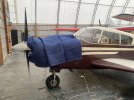- Joined
- Sep 11, 2019
- Messages
- 2,122
- Display Name
Display name:
Domenick
No Hassle Engine Pre-Heater – AntiSplatAero
 antisplataero.com
antisplataero.com
 antisplataero.com
antisplataero.com

Recently I had to make a flight with the temperatures in the mid 30's F.
That type of heater can and will turn the oil to coke on the heating probe. not what you want for your oil.No Hassle Engine Pre-Heater – AntiSplatAero
antisplataero.com
I have used it for 2 years and send my oil to Blackstone for testing every 25-35 hours with no issues. I take it out in the summer at an oil change and havent seen any type of burning or coking up on the unit. If anyone has, I would like to know. Maybe if it was left on all the time it could cause issues but I only leave it on to warm up before a flight.That type of heater can and will turn the oil to coke on the heating probe. not what you want for your oil.
I also think it is designed to be used while the oil is moving, otherwise it will burn the oil.
Yeah, but you live in Alaska. Living in Georgia, where my hangar temps (at least on flying days) are probably no lower than 15-20F on the worst days, a sump heater does a great job of bringing the entire engine up to ~100F after a night's use.That heater won’t burn 6+ quarts of oil sitting in 250# of chilled steel and aluminumI. I wouldn’t use one on its own any more than I’d use any sump heater without a top heat addition.
Bottom heat promotes corrosion. Geography has nothing to do with that.Yeah, but you live in Alaska. Living in Georgia, where my hangar temps (at least on flying days) are probably no lower than 15-20F on the worst days, a sump heater does a great job of bringing the entire engine up to ~100F after a night's use.
It's a sample of one, but 17 years of using bottom heat only, engine past TBO, no corrosion. I left the heat on most of the time because I was flying the airplane regularly. Bonanza with IO-550, an oil pan pad on each side (no clearance below) in Michigan, Minnesota and Wisconsin. But geography has nothing to do with that.Bottom heat promotes corrosion. Geography has nothing to do with that.
No Hassle Engine Pre-Heater – AntiSplatAero
antisplataero.com
I have started doing the same thing and keep my cowl covered and the air inlets plugged With an old moving pad. When I put the sump heater on overnight via my cell phone switch, I can come out in the morning and the engine bay is warm and the cylinders warm to the touch. Metal has good heat transfer characteristics. Works very well down to 20 degs ambient, hangar at about 28 degs. Colder than 20 degs ambient and it is to cold for me to want to fly.I had a Tannis on my IO-540 (182-S) that included the cylinder heaters. When I had a JPI 830 installed the drilled bosses where the heater elements were attached had to be used for the cylinder head probes so that left me with just the oil pan warmer. Recently I had to make a flight with the temperatures in the mid 30's F. The airplane was in a large non-insulated, non-heated hangar and I left my Tannis plugged in overnight. I closed the cowl flaps and put in the cowl plugs. The next morning the oil was definitely warm to the touch...much warmer than I expected. Also, the #1 and 2 cylinders were warm to the touch but colder than the oil for certain. I would guess, based on temp immediately after starting, the oil temperature was in the mid 70's F. I was concerned that eliminating the cylinder elements would be an issue but now I don't think so. If I was in a much colder climate or outside I definitely would desire keeping the cylinder heating function.
I agree with what you are saying for a Lycoming since the cam is not bathed in oil like the Continental. But if you only heat (sump heater only here) when you are going flying, then if you fly for an hour on more with oil temps at 170-180 degs, the heating of the oil gets rid of the moisture in it. BTW- what do you do after you fly to get the moisture out of the engine as the engine and oil cool down in 20-30 degs ambient temps? FWIW…. This topic comes up every winter.Try that on a Lycoming. Continentals aren’t immune but they do have better resistance to cam cancer. In any case, it’s a poor way to preheat cylinders. The colder the ambient temps the more that’s true. Air cooled cylinders are designed to be cooled by outside air.
At any rate, y’all should do what you think is best for your engines. Happy flying.
Think it would work well and fit into cowling of a Cirrus SR22?I just ferried an Arrow 800 miles in sub-freezing temps, including an overnight stop. I used a "twin hornet" engine heater each time. The engine started easier than a summer day each time.
You mean an oil fryer. They have been known to overheat the oil causing damage to the all important additives. A small foot heater with clothes dryer vent hose blowing warm air under the engine in such an arrangement that prevents fuel from dripping on the heater makes a wonderful engine heater.That should be called an oil heater, not an engine heater.
Under 75 watts only for me.. thermostat or notNo Hassle Engine Pre-Heater – AntiSplatAero
antisplataero.com
yepThink it would work well and fit into cowling of a Cirrus SR22?
